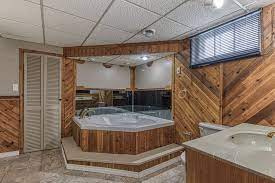Hot tubs are a popular addition to many homes, offering a relaxing and therapeutic experience for homeowners and guests alike. While hot tubs are typically installed outdoors on decks or patios, some homeowners may wonder whether it is possible to install a hot tub in their basement. In this article, we will explore the pros and cons of installing a hot tub in a basement and provide some tips for doing so safely and effectively.
Pros of Installing a Hot Tub in a Basement
There are several advantages to installing a hot tub in a basement, including:
- Privacy: A hot tub in the basement provides greater privacy than one installed outdoors, allowing homeowners to relax and unwind without worrying about nosy neighbors or passersby.
- Protection from the Elements: When installed indoors, a hot tub is protected from the elements, including rain, wind, and snow. This can help to prolong the life of the hot tub and reduce the need for maintenance.
- Increased Use: An indoor hot tub can be used year-round, regardless of the weather conditions outside. This can make it a more practical and cost-effective investment for homeowners who want to enjoy the benefits of a hot tub without worrying about the weather.
- Aesthetic Appeal: A hot tub in the basement can add a unique and luxurious touch to the home’s interior design, providing a focal point for the room and enhancing its overall aesthetic appeal.
Cons of Installing a Hot Tub in a Basement
While there are many advantages to installing a hot tub in a basement, there are also some potential drawbacks to consider, including:
- Space Limitations: Basements are often smaller than outdoor areas, which may limit the size of the hot tub that can be installed. Homeowners should carefully measure the available space and consider the size of the hot tub before making a decision.
- Structural Limitations: The weight of a hot tub, when filled with water and occupants, can be substantial, and may require additional structural support to be installed in the basement. Homeowners should consult with a structural engineer to ensure that the basement can safely support the weight of the hot tub.
- Moisture Control: Hot tubs generate a significant amount of moisture, which can lead to mold and mildew growth if not properly controlled. Homeowners must ensure that the basement has adequate ventilation and dehumidification to prevent moisture-related issues.
- Electrical Requirements: Hot tubs require a dedicated electrical circuit, and homeowners may need to have electrical work done to accommodate the installation. This can be costly and time-consuming, and homeowners should factor these costs into their decision-making process.
Tips for Installing a Hot Tub in a Basement
If you have decided to install a hot tub in your basement. Here are some tips to help you do so safely and effectively:
Choose the Right Hot Tub:
Before purchasing a hot tub, make sure to choose a model that is appropriate for indoor use. Look for models that are designed for small spaces and have lower water capacity to ensure that. It will fit in your basement and be safe to use.
Consider the Drainage System:
Hot tubs require proper drainage to prevent flooding and water damage. Consider installing a floor drain in the basement or connecting. The hot tub to the existing plumbing system to ensure proper drainage.
Install Adequate Ventilation:
Hot tubs generate a significant amount of moisture, which can lead to mold and mildew growth if not properly controlled. Make sure that the basement has adequate ventilation. Such as a dehumidifier or ventilation fan, to remove excess moisture and prevent issues.
Ensure Proper Electrical Requirements:
Hot tubs require a dedicated electrical circuit, and homeowners may need to have electrical work done to accommodate the installation. Consult with a licensed electrician to ensure that the electrical system can handle. The hot tub’s power requirements and that all electrical work is done safely and up to code.
Consider Structural Support:
Hot tubs are heavy, and the weight of the tub, water. And occupants can put a significant amount of stress on the basement’s structural components. It may be necessary to install additional support beams or columns to ensure that the basement can safely support the hot tub’s weight.
Hire a Professional:
Installing a hot tub in a basement can be a complex and challenging project that requires specialized knowledge and expertise. Consider hiring a professional hot tub installer or contractor to help with the installation process to ensure that everything is done safely and correctly.
Conclusion
While it is possible to install a hot tub in a basement. There are several factors to consider before making a decision. Homeowners must take into account the space limitations, and structural requirements. Moisture control, and electrical requirements before installing a hot tub in their basement. By carefully planning and preparing for the installation. Homeowners can enjoy the benefits of a hot tub in the comfort and privacy of their own home.

